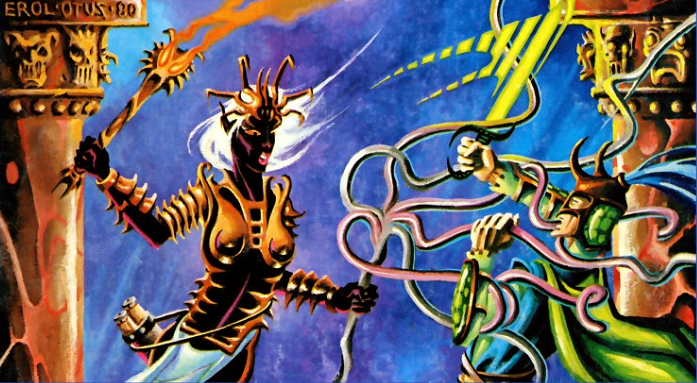Since their first appearance in 1977 with Hall of the Fire Giant King (module G3), drow have electrified the imaginations of gamers and fantasy nerds alike. Elves are graceful and beautiful — turn them into evil elves, and they become addictive.
Over the course of the past forty-plus years, they’ve evolved, and gamers with visions of Drizz’t Do’Urden dancing in their heads should update themselves on 5e game mechanics before choosing to play a drow.
But, before we delve into drow as playable characters in this drow 5e guide, let’s run through drow as “monsters” for your characters to encounter.
The Drow as Monsters
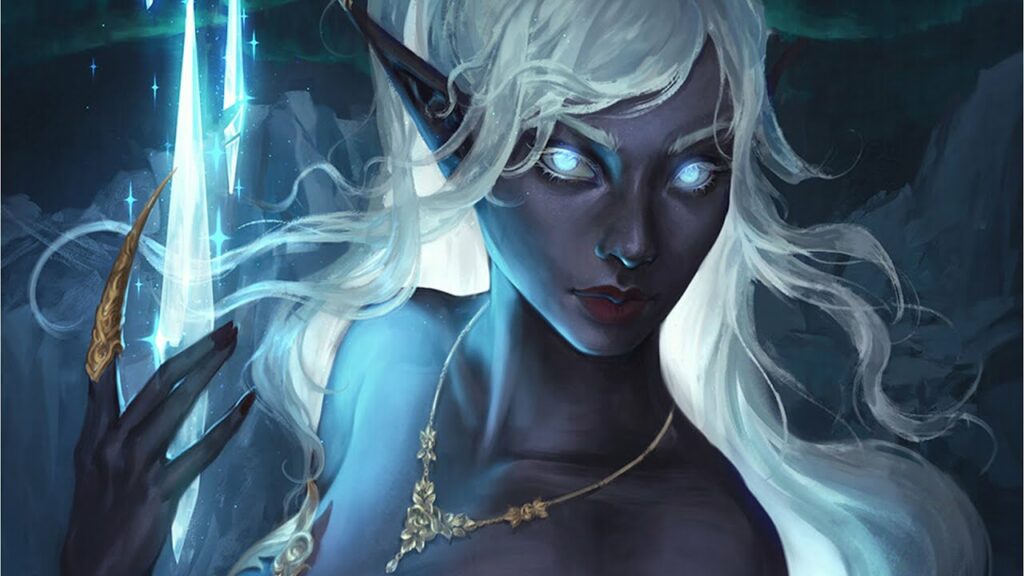
Every Dungeons & Dragon adventure, if successful, is basically a retelling of Joseph Campbell’s monomyth. The heroes enter the underworld, a dungeon, kill a monster, such as a dragon, take its treasure, and go home.
When they return home, they are not quite the same as before they had left; they’ve probably gained at least one level of experience.
If there was just one monster to fight, the adventure would be over in thirty minutes. Like any good adventure story, there needs to be all sorts of encounters and challenges along the way, not just with monsters but also with tricksters, guides, mentors, and even potential spouses.
In a D&D setting, there is room for some of this too, but, generally, every dungeon needs to be well-stocked with monsters. As important as role-playing and problem-solving are to the game, most players would not want to go through too many gaming sessions without having the chance to kill something.
For the most part, monsters have to be monsters, or their extermination and the looting of their belongings become problematic on ethical grounds. While the typical monster of myth is some primordial, disgusting, horrifying beast, drow are something different.
Drow are not disgusting; they are attractive. They are also intelligent and very civilized, with an advanced culture governed by strict rules.
To have an attractive, intelligent, and civilized villain is chilling in a very different way than having to battle a primordial beast. Now imagine an entire society that is this way, beautiful, brilliant, refined, and evil to the core. This is the Drow.
Interesting read: How to Name Your Drow Character.
Here are their Stats
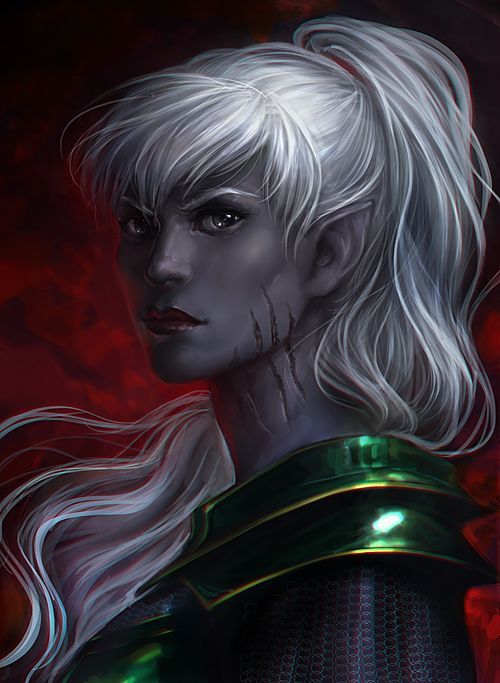
- Appearance: Like most elves, drow are slender and attractive. Unlike most elves, their skin is dark, usually black, but sometimes dark blue, dark purple, or brown. Their hair is white or pale yellow.
- Their eyes tend to be red or white with tints of blue, lilac, pink, or silver.
- A rare form of drow, Szarkai, are albino and have pale white skin.
- Alignment: neutral evil
- Size: Medium
- Armor Class: 15 (chain shirt)
- Hit Points: 13 (3d8)
- Speed: 30 ft.
- Skills: Perception +2, Stealth +4
- Senses: Darkvision 120 ft, Passive Perception 12
- Languages: Elvish, Undercommon
- Challenge: ¼ (50 XP)
- Proficiency: +2
- Spells: Dancing Lights (at will)
- Faerie Fire (1x/day)
- Darkness (1x/day)
- Magic resistance due to Fey ancestry: immunity to being put to sleep
Advantage on saving throws against being charmed
- Disadvantage: Drow are sensitive to sunlight, so under such conditions, they have a disadvantage to attack roles and perception checks that rely on sight.
- Poison: Drow are often equipped with poisonous crossbow bolts.
- Proficiencies: Hand crossbow, shortsword, and rapier
- Average ability scores:
STR 10 (+0), DEX 14 (+2), CON 10 (+0), INT 11 (+0), WIS (+0), CHA 12 (+)
- Lifespan: About 750 years
Sleep unnecessary. Trance for 4 hours a day is enough.
As you can see from the stats above, it would be a mistake to make a party of 1st level characters fight drow. A good 3rd level party might be enough to fight a couple of Drow, but even that would be a mistake if 3rd level characters had to fight the Drow one-on-one.
The reason is that drow represent an intelligent, magic-wielding, poison-wielding enemy with good stealth capability. Drow would never attack in sunlight, so if you meet them in the dark, or even worse, the Underdark, you are fighting them where they are at their best.
A typical Drow patrol in the Underdark would be difficult to surprise and would set up an ambush. If undetected, they open up with poisonous crossbow bolts before throwing the whole party in a Darkness spell.
Depending on the size of the patrol, they will have higher-level characters capable of casting various cleric or wizard spells.
As much as drow love raiding villagers, they would never sacrifice their prized soldiers when expecting heavy resistance. For meat shields needing to be sacrificed, they have plenty of conscripts from other races: goblins, orcs, hobgoblins, troglodytes, bugbears, and trolls.
They also have giant lizards as steeds and various types of giant spiders as pets. When facing the most dangerous opponents, drow can enlist the aid of an array of fiends, undead, and other fearsome allies.
The point is that it is bad DM’ing to use the Drow as cannon fodder. They are not there to serve as some 3 HD monster for some high-level player characters to kill in wave after wave. As a society, they are a very capable enemy when well-played by a DM.
At mid-level, the DM can see how players deal with a Drow patrol. At higher levels, the DM can have the players plan a raid on a Drow shrine with some human-sacrifice-practicing Priestess of Lolth as “The Big Bad.”
At the very highest levels, 10th or higher, the players can explore the Underdark and visit a Drow city. Maybe for The Big Bad, they can fight the demonic spider-goddess Lolth herself.
Vault of the Drow
Vault of the Drow (Module D3) is a 1st edition module, but any DM worth their salt should have a home-brewed 1e-to-5e conversion kit.
For those who want a drow-centered module in the Greyhawk setting, there is none better than Vault of the Drow. This module is equipped with a fully-mapped drow city, Erelhei-Cinlu. There is a complete description of the political situation.
Noble houses and merchant clans are continuously locked in power struggles, and yet, all function within the rules of their society. Lolth-worshipping is the dominant religion, but there are other rival gods as well, such as Tharizdun and the Cult of the Elder Elemental Eye, an evil elemental cult supported by House Eliservs.
Due to their close proximity to their “vault” and the personal presence of their deity, Lolth, their city radiates magic. Therefore, magic items are in abundance.
The typical drow soldier will have weapons, armor, and shield of a minimum +1 strength, with higher ranking society members being equipped with anything from +2 to +5 strength magical equipment. These items only retain their magical properties when within reasonably close proximity to Erelhei-Cinlu.
As far as challenges, leading up to The Big Bad, there are plenty of monsters, both drow controlled and otherwise: kua-toa (fish-people), illtihids (mind-flayers), a murderous mixed couple (a succubus married to a drow vampire), drow street gangs that don’t like the system and could become allies.
Merchant caravans and drow slavers that use lower races to do the heavy fighting (troglodytes, bugbears, and trolls), drow nobility that carry death lances and ride giant lizards into battle, attractive drow priestesses that are always happy to find a new sacrificial offering for Lolth, and of course, once you fight your way past the last Drow priestess and a demon or two, you get a chance to meet the Big Bad herself, Lolth.
Even for gamers who would prefer a Forgotten Realms setting or to even “homebrew” their campaign, Vault of the Drow is a must-have for fans of a drow-centered campaign, if only as a guide.
Menzoberranzan
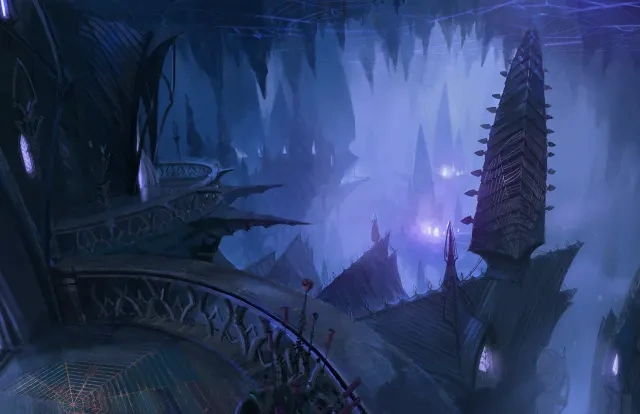
In the Forgotten Realms setting, no one has been more responsible for developing drow society than RPG fiction-writer R.A. Salvatore. In his Dark Elf Trilogy,
Salvatore created a drow city, Menzoberran, that was the homeland of his Drow hero, Drizz’t Do-Urden, a good-hearted drow ranger who rebels against the evil of the society he was born into.
This series has led to many books and other media that have depicted this city. Thanks to Salvatore and his emulators, there is ample literature describing day-to-day life in Menzoberranzan.
DMs seeking to create drow NPCs have ample material for models:
- Matron Malice is a good example of a Drow matriarch from a noble house, and her daughters are good models for priestesses of Lolth.
- Driszz’t’s brother Dinin and other nobles like Tiago Baenre and Baenre are good examples of male Drow nobility and warriors.
- Anton De Vay and Masoj Hun’ett are Drow wizards.
- Jarlaxle is a great drow anti-hero, a wandering mercenary
- The currently popular Baldur’s Gate III has a romance option with Minthara, a drow NPC cleric from Menzoberranzan.
I can’t stress this enough for DMs. If you introduce drow into your campaign, don’t cheat yourself or the players. Make them worthy adversaries and interesting NPCs. You certainly have enough material to work with.
Driders
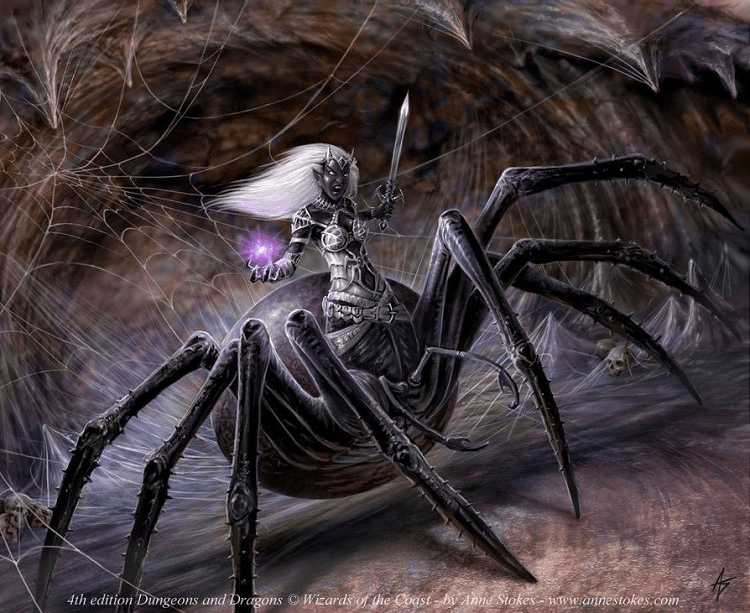
Worth honorable mention are driders, a subrace of the drow. Driders are to drow as centaurs are to humans. From the waist down, they are a giant spider. From the waist up, they are drow. Being transformed from a drow into a drider is considered a fate worse than death.
Characters
Why fight a drow when you could be one?
If you want the evil option, you can always worship Lolth or go with one of her evil competitors.
If you want the good option, you can always follow in Dirzz’t’s footsteps and shock people by being a living iconoclast, a good-hearted drow that saves people instead of murdering them.
Or, you don’t have to limit yourself. Just be a drow that is not trying to save or murder anyone in particular and is not seeking to be pinned down. Perhaps a neutral rogue?
The Drow has some pretty cool advantages with no actual disadvantages when considering character abilities, like Strength, Dexterity, etc. Like all elves, they have a +2 for Dexterity, and as drow, they get a +1 for Charisma.
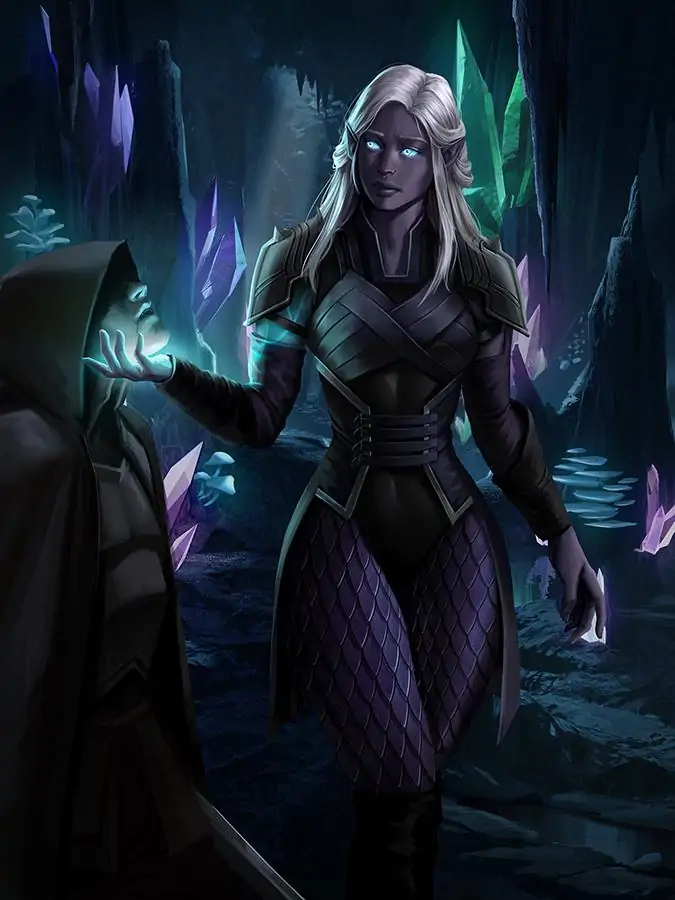
That means drow characters would have a natural advantage as rogues, bards, warlocks, sorcerers, and, oddly enough, rangers, monks, and paladins.
Player characters of the drow race are automatically proficient in the following weapons:
short sword, rapier, hand crossbow
Just like the drow as monsters, drow player characters have the same advantages and disadvantages regarding darkvision and sunlight.
As player characters, not monsters, drow have the following innate spellcasting abilities:
- Dancing lights
- Faerie fire 3rd level and up
- Darkness 5th level and up.
Regarding innate spellcasting, drow player characters aren’t what they used to be. In 1st edition rules, drow gained Darkness spell earlier and could Levitate after 4th level. In Salvatore’s Dark Elf books, Drizz’t used Darkness and Levitate quite freely.
Multiclassing
Multiclassing was also popular with 1e drow player characters and NPCs, but that decision has to be weighed more carefully with 5e rules. The reasons for this are due to minimum ability score requirements and how experience points are divided between the classes.
Drow Character Build
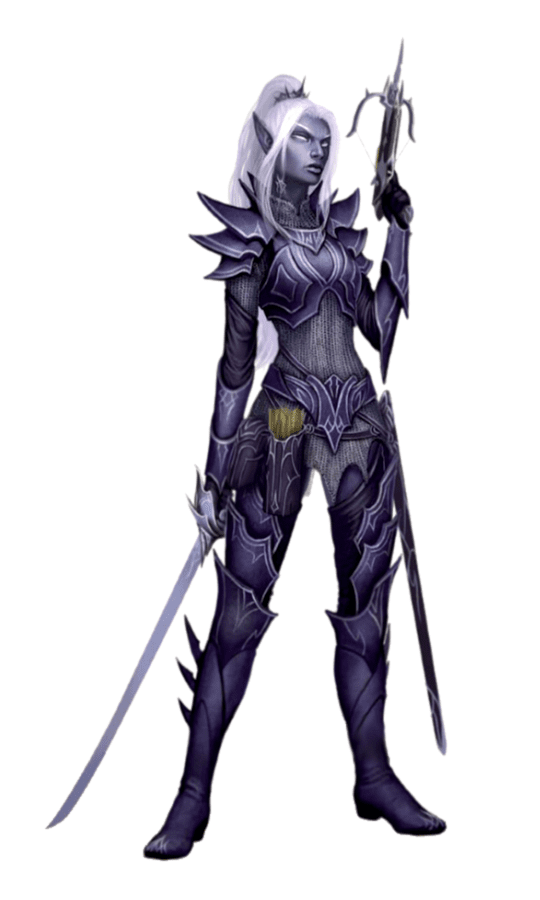
One of the fun parts about D&D for experienced players is finding new interesting character builds. Let’s say we use the standard set of scores supplied by the Player’s Handbook:
15, 14, 13, 12, 10, 8
Obviously, the +2 Dexterity could go to the 15 for a whopping 17 Dexterity with a +3 modifier.
The obvious choice would be to create a very persuasive rogue. It sounds harsh, but the rogue could put the 8 on Wisdom or Intelligence. That would be your character’s excuse for getting into trouble and having lots of adventures.
However, the wiser allocation would dictate adding the +1 Charisma to the 15 for a score of 16 and the +2 Dexterity to the 14 for another score of 16.
This is because the modifier for 17 is no better than the modifier for 16, so the two 16s are better than one 17. In this way, you can have two +3 modifiers for Dexterity and Charisma.
A skinny but agile rogue could have a low strength to justify their reliance on dishonorable sneak attacks. As long as they use ranged and finesse weapons, a low strength is not a problem.
Therefore, Dexterity and Charisma 16, Strength 8.
While an agile and charismatic thief might be downright adorable, your drow could be a warlock, sorcerer, or bard just as easily, with double 16s.
Their +3 Charisma modifier would be great for casting spells and could use their +3 Dexterity modifier for ranged and finesse weapons as well as defense. IMHO, this is even a better choice than the rogue build for Drow.
Ok. So, we’ve narrowed our top build down to three. Which one?
If weapon proficiencies were stackable, bard would be the best choice. You could use racial weapon proficiency with class proficiency and get +4 to nearly all drow weapons (rapier, short sword, hand crossbow) to add to your +3 Dexterity modifier for +7 total for any of those three weapons! Sadly, that is not to be.
Rather than stack, your weapon proficiencies would overlap, and your total would be +5, which still isn’t bad. The same is true for rogues. Bards would be able to add light armor and spells.
We, however, are looking for the ideal build, leaving only two options.
Since weapon proficiencies don’t stack, drow sorcerers and warlocks can use their racial proficiencies to have access to weapons they may not otherwise have. Let’s say our drow chooses a rapier as their main weapon because it is a finesse weapon and does more damage than a short sword.
Warlocks don’t really gain any weapon proficiencies, but sorcerers do, and none of them are automatic for drow: daggers, darts, slings, quarterstaffs, light crossbows. So, from a weapon proficiency standpoint, sorcerer is the best choice.
On the other hand, Warlocks have more survivability because they can wear light armor and use an 8-sided die rather than a 6-sided die for hit points.
Long Rest vs Short Rest
Of course, the real reason why players pick warlock is the short rest. The ability to recharge all spells after a short rest is a ridiculous advantage, especially at the lower levels when spell slots are hard to come by. Warlock wins!
Now that we’ve made some of the key decisions let’s check my quick drow character build, a female warlock named Semiramis.
Semiramis the Drow Warlock

| Semiramis the Drow Warlock |
| STR 8 (-1) |
| INT 10 (0) |
| WIS 12 (+1) |
| DEX 16 (+3) |
| CON 13 (+1) |
| CHR 16 (+3) |
| Hit Points 9 (1d8 +1) |
| AC 15 (studded leather + Dexterity) |
| Melee weapon- rapier with +5 bonus damage (d1-8 +5) |
| Melee weapon- shortsword with +5 bonus damage (d1-6 +5) |
| Missile weapon- hand crossbow with +5 bonus damage (d1-6 +5) |
Note that this is a quick build to show what works best for drow characters. Particular warlock pacts, spells, and backgrounds could be added later.
That being said, Eldritch Blast cantrip is a must for any warlock, and the 1st level Sleep Spell via Pact of the Fey is also interesting. Of course, Dancing Lights cantrip gets added for free, as will Faerie Fire and Darkness eventually.
If I choose backgrounds, I would probably ask my DM if I could build a drow warlock criminal background. I would get Stealth and Deception as skills and use my Charisma to sell my thieves’ tools to buy some studded leather armor.
If not, I could be an entertainer and get Acrobat and Performer and sell my instrument.
How does Your Drow Warlock Character Build (Pun Alert) Stack up Against Bruenor, the Dwarf Fighter Character Build Template from PHB?
Let me show you…
Bruenor vs Semiramis:
Obviously, as we would expect from a dwarven fighter, Bruenor would have a distinct advantage over Semiramis in both AC (Armor Class) and HP (Hit Points). Considering that Semiramis is primarily a spellcaster and not a warrior, the difference is not that extreme.
| Character | Armor Class | Hit Points |
| Bruenor | 18 | 13 |
| Semiramis | 15 | 9 |
So Bruenor has a 3-point advantage in AC and a 4-point advantage in HP. Remember, this is what Bruenor does. As a fighter, that’s pretty much all he does. No spells. No real stealth.
That’s where Bruenor’s advantage ends.
Here are range attacks without magic:
| Character | LR 600 Mod | NR 150 Mod | LR 120 Mod | 60 LR Mod | 30 NR Mod | 20 NR Mod |
| Bruenor | 0/0 | 0/0 | NA | 0/0 | 0/0 | +5/+3 |
| Semiramis | 0/0 | 0/+3 | 0/0 | 0/0 | +5/+3 | +5/+3 |
So, what does this table above mean? It represents a ranged attack battle between Bruenor and Semiramis without magic.
At 600 feet to 151 feet, if they choose longbows, they would be on an equal footing. Neither has this proficiency, and they both have a disadvantage at long range, so the modifier is 0/0.
At 150 feet, however, Semiramis starts to win in a longbow duel. Even though Semiramis doesn’t have proficiency in longbow use, she does get +3 modifier to both attack and damage rolls with any ranged weapon, provided that it is within normal range.
Since Bruenor can only move at 25 feet per turn, Semiramis could use her longbow to get about six attacks on him before he gets within five feet of her for melee. Of course, in the real world, a character with 8 Strength might have trouble with a longbow against chainmail, but I believe PHB rules don’t discuss that.
Let’s say they don’t use longbows and instead opt for the ranged weapons that they’re proficient in, Bruenor’s handaxe vs. Semiramis’s hand crossbow. Semiramis can start making long-range attacks, with no bonus, at 120 feet.
With Bruenor’s movement at 25 feet per turn, Semiramis could get two or three free attacks on him before he even gets into range to use his hand ax.
At 60 feet, most DMs would put the two duelists at about even modifiers until the melee begins. Bruenor is at long range from 60-20 feet. Semiramis is at long range from 120 to 30 feet.
The ten-foot difference for normal range might be negligible if one of them is advancing and shooting/throwing. At 20 feet, when both are at normal range, their modifiers are equal.
Bruenor gets a +2 for proficiency and a +3 for strength for a total of +5 on his attack roll, and he gets a +3 for strength for a total of +3 on his damage roll, for a total of 4-9 damage.
Semiramis gets a +2 for proficiency and a +3 for dexterity for a total of +5 on her attack roll, and she gets a +3 for dexterity for a total of +3 on her damage roll, for a total of 4-9 damage.
Every time Semiramis loads and fires her hand crossbow, she would take one turn. Every time Bruenor draws and throws his hand ax, he would take one turn, provided he has more than one ax. If he has only one ax, he would be at a severe disadvantage for such a fight.
Looking at the battle above, there would be many situations in which Semiramis would have a clear advantage over Bruenor in a ranged attack battle without magic. Now let’s look at melee combat, Bruenor’s bread and butter.
| Character’s Weapon | Attack/Damage Mod and Total |
| Bruenor’s Battle-Axe: 1-Handed
w Shield |
+5/+3 D 1-8 +3/ T 4-11 AC 18 |
| Bruenor’s Battle-Axe: 2-Handed w/o Shield | +5/+3 D 1-10 +3/ T 4-13 AC 16 |
| Semiramis’s Rapier | +5/+3 D 1-8 +3/ T 4-11 AC 15 |
| Semiramis’s Rapier and
Short Sword: 2-Handed Fighting |
+5/+3 D 1-8 +3/ T 4-11 AC 15
+0/+0 D 1-6 Grand Total 5-17 |
So, if the two were to fight normally, Bruenor with his ax and shield and Semiramis with her rapier, they would be evenly matched as far as modifiers and damage. Bruenor, of course, would have an advantage with armor class and hit points, which would make a difference.
He could increase his damage by two potential points if he drops his shield and wields his ax with both hands, but he would have to sacrifice 2 points on his AC.
However, if Semiramis were to draw a short sword and use two-handed fighting to attack with her short sword as a bonus action, she could do additional damage, albeit with no extra modifiers for her short sword.
The difference is that this costs her nothing unless she wants to take a different bonus action. This would negate some of Bruenor’s advantage in hit points and AC and make them almost evenly matched in a melee.
Of course, if Bruenor wanted to, he could drop his shield, draw his hand ax, and engage in Two-Weapon fighting with a battleax in one hand and a hand ax in the other.
Their attack and damage modifiers would be identical in that situation, as would their potential damage per round. Bruneor would give up most of his AC advantage but still have a considerable advantage in hit points.
The point of the above is to show that the Drow warlock character build is good enough to compete against a fighter in both ranged and melee attacks without magic.
With magic, Semiramis could use 1st level spells like Sleep to annihilate Bruenor. Due to her Eldritch Blast, she could even kill him with cantrips. At 120 feet, she could nail him 4-5 times for 4-50 points of damage before he even gets within melee range.
The above is for combat situations. In social interactions, Bruenor could use his wisdom, and Semiramis could use her wisdom, her charisma, and possibly a spell or two.
This doesn’t mean that drow can’t be great for other classes as well or that being a dwarven fighter is a bad thing, but this is my case for warlock being the best drow character build.
FAQs
Question: Can Drow See in the Ultraviolet Spectrum?
Answer: Not anymore, but I believe Vault of the Drow mentioned that 1e drow could.
Question: Can Drow Eliminate their Daylight Disadvantage?
Answer: If I were the DM, I would allow the drow character to buy it off as a feat. Drizz’t apparently did this by meditating in the sunlight, as penance for his evil upbringing, day after day with progressively longer exposure over a period of several weeks.
Question: In Game Terms, how can I be Both Infamous and Charismatic because of My Race at the Same Time?
Answer: That’s a paradox the designers apparently haven’t worked out. Drow are naturally charismatic, but nobody trusts them. How could a drow character use their Charisma in social interactions?
As a DM, my answer would be that humans are complicated and often attracted to things they know are bad for them. An attractive, charismatic Drow could win over suspicious good-aligned characters unless they have a high Wisdom score.
There have been many situations where people see a smooth-talker for what they are and still wind up getting persuaded.
Conclusion
Drow are a great addition to any campaign, both as monsters and characters. Even if Drow characters have lost ultraviolent vision and their free levitation spell, the opportunities that come with a Drow warlock character build more than makeup for it.
- Perform Bewitching 5e Guide - October 1, 2022
- Inspiring Leader 5e Guide - September 20, 2022
- Scrying 5e Guide - September 19, 2022


